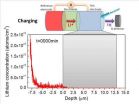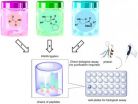(Press-News.org) The drug simeprevir (trade name: Olysio) has been available since May 2014 for the treatment of adult patients with chronic hepatitis C infection. In an early benefit assessment pursuant to the Act on the Reform of the Market for Medicinal Products (AMNOG), the German Institute for Quality and Efficiency in Health Care (IQWiG) examined whether this new drug offers an added benefit over the appropriate comparator therapy.
The drug manufacturer dossier provided indications and hints of an added benefit of simeprevir when the patients infected with hepatitis C virus (HCV) genotype 1 have been untreated before or have relapsed after initially successful treatment. It is not possible to rate the extent of added benefit, however. IQWiG sees an indication of considerable added benefit for adults with HCV genotype 1 infection in whom previous treatment had no effect (non-responders). There were no evaluable data for further therapeutic indications and thus an added benefit is not proven.
Different virus types cause inflammation
Hepatitis C viruses (HCV) attack the liver and can trigger inflammation there. If this becomes chronic, cirrhosis can develop and liver function progressively deteriorates. Moreover, the risk of liver cancer (hepatocellular carcinoma, HCC) increases. Simeprevir aims to inhibit the reproduction of HCV. Experts assume that if no viruses are detectable in the blood over a sustained period after treatment (sustained virologic response, SVR), the risk of secondary disease is reduced.
There are six different main types (genotypes) of the hepatitis C virus, which are subdivided into more than 60 subtypes. The effectiveness of different drugs is not the same against all viruses. Genotype 1a is more common in the United States, whereas genotype 1b is more common in Europe.
Comparison with dual therapy or triple therapy
Simeprevir is administered in addition to the drugs peginterferon alfa and ribavirin, which are already on the market; and in certain cases it is administered in addition to sofosbuvir and ribavarin. According to the approval, treatment duration differs for certain patient groups.
Depending on patient characteristics, the options for the comparator therapy are dual therapy with peginterferon alfa (immune-system enhancing drug) and ribavirin (virostatic drug), and triple therapy, in which peginterferon alfa and ribavirin are additionally combined with a protease inhibitor (boceprevir or telaprevir).
For adults with chronic HCV genotype 1 infection without cirrhosis of the liver, the Federal Joint Committee (G-BA) specified both dual therapy and triple therapy as appropriate comparator therapy. In its dossier, the manufacturer differentiated between three groups: untreated (treatment-naive) patients, patients with unsuccessful pretreatment (non-responders), and patients who relapsed after initially successful treatment (relapsed patients).
Simeprevir was only to be compared with dual therapy in treatment-naive patients with cirrhosis of the liver, in patients with chronic HCV genotype 1 infection and additional HCV infection as well as in patients with chronic HCV genotype 4 infection.
Extent of added benefit cannot be classified on the basis of the surrogate outcome for morbidity
"Sustained virologic response (SVR)" is not in itself a patient-relevant outcome and cannot be equated with "cure". And there are no studies in which SVR is validated as a surrogate outcome in accordance with the usual criteria employed by IQWiG. Nevertheless, the Institute accepts SVR here as a surrogate for the reduced incidence of liver cancer. This is because it is currently accepted that patients with no detectable hepatitis C virus in the blood are at lower risk of liver cancer.
However, it is unclear how many cases of liver cancer can in fact be prevented by simeprevir. It is therefore unclear whether an added benefit is "minor", "considerable" or "major". According to the corresponding legal ordinance, the added benefit is thus "non-quantifiable".
Indication of an added benefit for adults without prior treatment
Data from three studies were available for treatment-naive patients with HCV genotype 1 infection (with or without cirrhosis of the liver) (PILLAR, QUEST-1 and QUEST-2). All study participants received simeprevir or placebo in combination with peginterferon alfa and ribavirin (dual therapy). Age, fibrosis score and two molecular biological factors (Q80K polymorphism and variants of interleukin 28B) are so-called effect modifiers and influenced the study results on morbidity and side effects.
With regard to SVR, there is an advantage of simeprevir: Depending on effect modifiers, there is an added benefit (indication or hint) for certain patients, which is non-quantifiable.
Simeprevir offers advantages on further aspects of morbidity: In some people, fatigue and global health status improved more than in the comparator group. Certain patients had fewer serious side effects. There were no differences between the treatment groups with regard to mortality; and there were no evaluable data on quality of life. Overall, IQWiG determined an added benefit of simeprevir with the probability "indication" or "hint" for certain patients. In all cases, the extent is non-quantifiable. An added benefit is not proven for patients with a variant of interleukin 28B (IL28B CC genotype).
Indication of added benefit for relapsed patients
Adults with HCV genotype 1 infection who relapsed after initially successful treatment (relapsed patients) participated in the study presented (PROMISE). They received simeprevir or placebo in combination with peginterferon alfa and ribavirin (dual therapy).
Treatment with simeprevir had advantages also in these patients: There was an indication that simeprevir increased the likelihood of being virus-free after the treatment (SVR). However, it remained unclear how often the drug can actually prevent liver cancer. The positive results on further outcomes, such as fatigue, global health status and number of severe side effects (e.g. gastrointestinal and nervous system disorders) are influenced in different ways by effect modifiers: sex, genetic subtype of the virus (genotype 1a or 1b), fibrosis score and Q80K polymorphism.
Overall, there is also an indication of a non-quantifiable added benefit of treatment with simeprevir for this patient group.
Considerable added benefit for non-responders
The manufacturer presented results from a study (ATTAIN), in which simeprevir was compared with telaprevir, for adults with chronic HCV genotype 1 infection with unsuccessful prior therapy (non-responders). Each of the two drugs was used in combination with peginterferon alfa and ribavirin (triple therapy).
There were no differences between the treatment groups with regard to mortality, secondary diseases, fatigue, depression and global health status. Serious side effects and premature treatment discontinuations due to side effects occurred in both groups. Both were less frequent in the simeprevir group, however, including anaemia as serious side effect. Skin and gastrointestinal disorders were also less frequent under simeprevir. Overall, an indication of major added benefit can be derived from the positive effects.
No sufficient data for patients with HIV coinfection and for genotype 4
The manufacturer cited one study each for the assessment of the added benefit of simeprevir in adults with HCV genotype 1 infection and HIV coinfection as well as in patients with HCV genotype 4 infection. However, the dossier lacked a systematic search and appraisal of the available evidence on the comparator therapy so that the data presented were unsuitable. Hence no added benefit of simeprevir is proven for these patients.
G-BA decides on the extent of added benefit
The dossier assessment is part of the overall procedure for early benefit assessments supervised by the G-BA. After publication of the manufacturer's dossier and IQWiG's assessment, the G-BA conducts a commenting procedure, which may provide further information and result in a change to the benefit assessment. The G‑BA then decides on the extent of the added benefit, thus completing the early benefit assessment.
An overview of the results of IQWiG's benefit assessment is given by a German-language executive summary. In addition, the website gesundheitsinformation.de, published by IQWiG, provides easily understandable and brief German-language information on simeprevir.
The G-BA website contains both general English-language information on benefit assessment pursuant to §35a Social Code Book (SGB) V and specific German-language information on the assessment of simeprevir.
INFORMATION:
More English-language information will be available soon (Sections 2.1 to 2.8 of the dossier assessment as well as subsequently published health information on informedhealthonline.org).
If you would like to be informed when these documents are available, please send an e-mail to info@iqwig.de.
Simeprevir in hepatitis C: Added benefit for certain patients
Added benefit for untreated and relapsed patients with unclear extent/ Considerable added benefit for non-responders/ Missing data for patients with HIV coinfection and genotype 4 patients
2014-09-08
ELSE PRESS RELEASES FROM THIS DATE:
Plant diversity in China vital for global food security
2014-09-08
With climate change threatening global food supplies, new research claims the rich flora of China could be crucial to underpin food security in the future.
A team from the University of Birmingham and partners in China have identified 871 wild plant species native to China that have the potential to adapt and maintain 28 globally important crops, including rice, wheat, soybean, sorghum, banana, apple, citrus fruits, grape, stone fruits and millet. 42% of these wild plant species, known as crop wild relatives (CWR) occur nowhere else in the world.
CWR are wild plant ...
Plant insights could help develop crops for changing climates
2014-09-08
Crops that thrive in changing climates could be developed more easily, thanks to fresh insights into plant growth.
A new computer model that shows how plants grow under varying conditions could help scientists develop varieties likely to grow well in future.
Scientists built the model to investigate how variations in light, day length, temperature and carbon dioxide in the atmosphere influence the biological pathways that control growth and flowering in plants.
They found differences in the way some plant varieties distribute nutrients under varying conditions, ...
First-ever look inside a working lithium-ion battery
2014-09-08
VIDEO:
Using a neutron beam, chemists and engineers at The Ohio State University were able to track the flow of lithium atoms into and out of an electrode in real time...
Click here for more information.
COLUMBUS, Ohio—For the first time, researchers have been able to open a kind of window into the inner workings of a lithium-ion battery.
Using a neutron beam, chemists and engineers at The Ohio State University were able to track the flow of lithium atoms into and out ...
Targeted immune booster removes toxic proteins in mouse model of Alzheimer's disease
2014-09-08
Alzheimer's disease experts at NYU Langone Medical Center and elsewhere are reporting success in specifically harnessing a mouse's immune system to attack and remove the buildup of toxic proteins in the brain that are markers of the deadly neurodegenerative disease.
Reporting on their experiments in the journal Acta Neuropathologica Communications online Sept. 3, the researchers say the work advances the development of more effective clinical treatments for Alzheimer's because their immune booster reduced both amyloid beta plaques and tau tangles. Previous immunomodulatory ...
Nearly half of older adults have care needs
2014-09-08
Nearly half of older adults – 18 million people—have difficulty or get help with daily activities, according to a new study.
Researchers from the University of Michigan and the Urban Institute analyzed data from a national sample of older adults drawn from Medicare enrollment files. In all, 8,245 people were included in the 2011 the National Health and Aging Trends Study. The analysis was published in the current (September 2014) issue of the Milbank Memorial Quarterly.
"Although 51 percent reported having no difficulty in the previous month, 29 percent reported receiving ...
The future of our crops is at risk in conflict zones, say Birmingham scientists
2014-09-08
Wild species related to our crops which are crucial as potential future food resources have been identified by University of Birmingham scientists, however, a significant proportion are found in conflict zones in the Middle East, where their conservation is increasingly comprised.
The scientists have identified 'hotspots' around the globe where crop wild relatives (CWR) – species closely related to our crops which are needed for future crop variety development – could be conserved in the wild in order to secure future global food resources.
The hotspot where CWR ...
New parasitoid wasp species found in China
2014-09-08
For the first time, wasps in the genus Spasskia (family: Braconidae) have been found in China, according to an article in the open-access Journal of Insect Science. In addition, a species in that genus which is totally new to science was also discovered.
The new species, Spasskia brevicarinata, is very small — male and female adults are less than one centimeter long. It is similar to a previously described species called Spasskia indica, but the ridges on some of its body segments are different. In fact, the species epithet brevicarinata reflects a short ridge on its ...
Unusual immune cell needed to prevent oral thrush, Pitt researchers find
2014-09-08
PITTSBURGH, Sept. 8 – An unusual kind of immune cell in the tongue appears to play a pivotal role in the prevention of thrush, according to the researchers at the University of Pittsburgh School of Medicine who discovered them. The findings, published online today in the Journal of Experimental Medicine, might shed light on why people infected with HIV or who have other immune system impairments are more susceptible to the oral yeast infection.
Oral thrush is caused by an overgrowth of a normally present fungus called Candida albicans, which leads to painful white lesions ...
'Pick 'n' Mix' chemistry to grow cultures of bioactive molecules
2014-09-08
Chemists at ETH-Zürich and ITbM, Nagoya University have developed a new method to build large libraries of bioactive molecules – which can be used directly for biological assays – by simply mixing a small number of building blocks in water.
Zürich, Switzerland and Nagoya, Japan – Professor Jeffrey Bode of ETH-Zürich and the Institute of Transformative Bio-Molecules (ITbM) of Nagoya University, and his co-worker have established a new strategy called "synthetic fermentation" to rapidly synthesize a large number of bioactive molecules, which can be directly screened in ...
Trial shows improved overall survival for patients with liver cancer not amenable to surgery
2014-09-08
Singapore, 04 September 2014 – The mature results from a trial conducted by the Asia-Pacific Hepatocellular Carcinoma Trials Group led by the National Cancer Centre Singapore (NCCS) and Singapore General Hospital (SGH) have shown that patients who suffer from inoperable advanced hepatocellular carcinoma (HCC) may have a chance to live significantly longer by using a combined therapy.
The multi-centre phase II clinical trial was conducted at four Asia Pacific tertiary medical centres to evaluate the efficacy of combining two existing treatment modalities, Sorafenib and ...
LAST 30 PRESS RELEASES:
A new way to map how cells choose their fate
Numbers in our sights affect how we perceive space
SIMJ announces global collaborative book project in commemoration of its 75th anniversary
Air pollution exposure and birth weight
Obstructive sleep apnea risk and mental health conditions among older adults
How talking slows eye movements behind the wheel
The Ceramic Society of Japan’s Oxoate Ceramics Research Association launches new international book project
Heart-brain connection: international study reveals the role of the vagus nerve in keeping the heart young
Researchers identify Rb1 as a predictive biomarker for a new therapeutic strategy in some breast cancers
Survey reveals ethical gaps slowing AI adoption in pediatric surgery
Stimulant ADHD medications work differently than thought
AI overestimates how smart people are, according to HSE economists
HSE researchers create genome-wide map of quadruplexes
Scientists boost cell "powerhouses" to burn more calories
Automatic label checking: The missing step in making reliable medical AI
Low daily alcohol intake linked to 50% heightened mouth cancer risk in India
American Meteorological Society announces Rick Spinrad as 2026 President-Elect
Biomass-based carbon capture spotlighted in newly released global climate webinar recording
Illuminating invisible nano pollutants: advanced bioimaging tracks the full journey of emerging nanoscale contaminants in living systems
How does age affect recovery from spinal cord injury?
Novel AI tool offers prognosis for patients with head and neck cancer
Fathers’ microplastic exposure tied to their children’s metabolic problems
Research validates laboratory model for studying high-grade serous ovarian cancer
SIR 2026 delivers transformative breakthroughs in minimally invasive medicine to improve patient care
Stem Cell Reports most downloaded papers of 2025 highlight the breadth and impact of stem cell research
Oxford-led study estimates NHS spends around 3% of its primary and secondary care budget on the health impacts of heat and cold in England
A researcher’s long quest leads to a smart composite breakthrough
Urban wild bees act as “microbial sensors” of city health.
New study finds where you live affects recovery after a hip fracture
Forecasting the impact of fully automated vehicle adoption on US road traffic injuries
[Press-News.org] Simeprevir in hepatitis C: Added benefit for certain patientsAdded benefit for untreated and relapsed patients with unclear extent/ Considerable added benefit for non-responders/ Missing data for patients with HIV coinfection and genotype 4 patients


